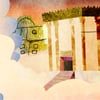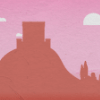At the time of King Solomon this mountain was 500 x 500 cubits. It had 5 points of entry:
South - Two Chuldah gates.
West - The Kiphonus gate.
North - The Tadi gate.
East - The Shushan gate.
(King Herod, who extended the Temple Mount area, added 3 additional gates to its western side.)
The focal point of the Temple Mount was a central courtyard containing the structure of the Bet Hamikdash. The rest of the Temple Mount area contained various rooms and buildings, including:
• House of Study, in which the Talmudic law was taught and discussed.
• Lounge for minor Temple officials.
• Weapons room, in case of enemy invasion.
• Tool room for repair work.
• Trumpet place. The shofar (ram's horn) was sounded from the roof of this building before the onset of the Sabbath to let the people know when they must refrain from work.
Chuldah Gates
These were the main doorways used to access the Temple mount, one gate was used as the entrance, while the other gate served as an exit.
The Prophetess Chuldah, would sit near this area during the final years of the first Temple, admonishing Jewish women to give up their idolatrous ways. When the Second Temple was built, these gateways were named after her.
Kiphonus Gate:
This gate took the visitor through a tunnel which led to the top of the Temple Mount. Near the outside of the gateway was a magnificent garden with many types of roses used in the compounding of the Temple incense - hence the name Kiphonus - rose garden in Greek.
Tadi Gate:
All the Temple gateways shared the same basic rectangular design. The Tadi gate, however, had a unique triangular shape. The name Tadi comes from the Greek word meaning "high". The angle formed at the top made this doorway higher or taller than the others.
Shushan Gate:
The Eastern Temple Wall had one gateway called the Shushan Gate. The Persian emperor Darius II, the child of Achashverosh (Xerxes) and Esther, gave the Jews permission to rebuild the Second Temple. As a token of indebtedness (or at the insistence of the emperor), the Jews placed a carving of the city of Shushan, the capital of the Persian Empire, above the gateway.
Engraved onto the wall outside the Shushan Gate were two markings indicating the length of a cubit. One marking was to the right of the gateway, one to the left. The marking on the wall to the right was half a "fingers' width" (etzbah) smaller than a true cubit. The marking on the left wall was a full "fingers' width" larger than a true cubit. Workers, who were paid in lengths of wood, were paid according to the smaller marker. Workers hired to cut a certain length of wood would measure it according to the larger marking. Whoever pledged a length of inexpensive material to the Temple would measure it according to the larger marking, while those who pledged a length of expensive material, such as a precious metal, would use the smaller marker.







Join the Discussion